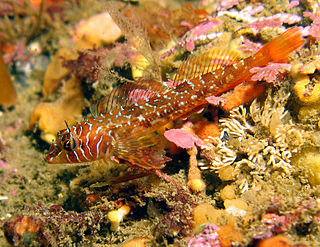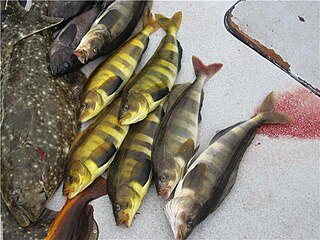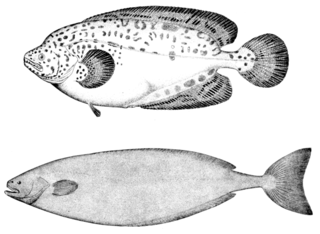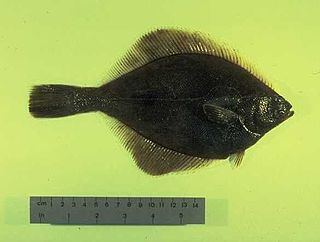 W
WHemilepidotus, the Irish lords, is a genus of sculpins native mostly to the northern Pacific Ocean and the Arctic Ocean.
 W
WJordania zonope, the longfin sculpin, is a species of sculpin native to the northeastern Pacific Ocean, ranging from Baranof Island (Alaska) to Point Lobos (California). It can be found at depths of 2 to 38 metres. This species grows to a length of 15 centimetres (5.9 in) TL. This species is sometimes displayed in public aquariums. This species is the only known member of its genus. Jordania Zonope is a demersal fish that is adapted morphologically and behaviorally to frequent a variety of rock surfaces and to feed on an array of prey types. The J.zonope are generally olive green, marked by a red-banded color pattern which blends well with their habitats. They are mostly found on rock faces, and there its coloration helps to camouflage it from predators.
 W
WSpirinchus is a genus of smelts (Osmeridae) from the North Pacific Ocean and adjacent streams.
 W
WThe longhead dab is a flatfish of the family Pleuronectidae. It is a demersal fish that lives on bottoms at depths of up to 160 metres (520 ft), though it is most commonly found between 10 and 125 metres. Its native habitat is the temperate waters of the northern Pacific, and it range stretches from the Sea of Okhotsk and the Kuril Islands to the Bering Sea and the arctic west coast of Canada. Males grow up to 40 centimetres (16 in) in length, though the common length is around 17.5 centimetres (6.9 in).
 W
WThe Bering flounder is a flatfish of the family Pleuronectidae. It is a demersal fish that lives on bottoms at depths of up to 425 metres (1,394 ft). It reaches up to 30 centimetres (12 in) in length. Its native habitat is the northern Pacific, from Japan and the Sea of Okhotsk across the Bering Sea to Alaska, the Aleutian Islands and Canada's Arctic coast.
 W
WFodiator acutus, the sharpchin flyingfish, is a species of flying fish in the genus Fodiator endemic to the northeast Pacific Ocean and the eastern Atlantic Ocean.
 W
WThe Atka mackerel is a mackerel in the family Hexagrammidae. Atka mackerel are common to the northern Pacific ocean, and are one of only two members of the genus Pleurogrammus - the other being the Arabesque greenling. The Atka mackerel was named for Atka Island, the largest island of the Andreanof islands, a branch of the Aleutians.
 W
WThe ragfish is a ray-finned fish of the northern Pacific Ocean; although a perciform, its skeleton is mostly cartilage, and the larvae have pelvic fins that disappear as they mature. It is the sole member of the family Icosteidae, and some authorities place it into its own order Icosteiformes.
 W
WThe chum salmon is a species of anadromous fish in the salmon family. It is a Pacific salmon, and may also be known as dog salmon or keta salmon, and is often marketed under the name silverbrite salmon. The name chum salmon comes from the Chinook Jargon term tzum, meaning "spotted" or "marked", while keta in the scientific name comes from the Evenki language of Eastern Siberia via Russian.
 W
WThe grunt sculpin or grunt-fish is a small fish mainly found in the eastern Pacific Ocean. The grunt sculpin generally remains close to shore and is often found in empty giant barnacle shells. It was first identified by Albert Günther in 1874 and was named in honor of naturalist John Richardson. The common name comes from reports that the fish vibrate or "grunt" when held. Its defining feature is its tendency to “hop” along the ocean floor on its orange fins. The short, stout body of the grunt sculpin has a long, small mouth which is adapted for eating smaller prey.
 W
WThe deepsea sole is a flatfish of the family Pleuronectidae. It is a bathydemersal fish that lives on muddy bottoms at depths of between 41 and 1,800 metres, though it is most often found at depths of 500 to 950 metres. Its native habitat is the northern Pacific, from Japan to the Gulf of Alaska and down the Pacific coasts of Canada and the USA as far south as Mexico. It grows up to 47 centimetres (19 in) in length.
 W
WThe flathead sole is a flatfish of the family Pleuronectidae. It is a demersal fish that lives on soft, silty or muddy bottoms at depths of up to 1,050 metres (3,440 ft). Its native habitat is the northern Pacific, from the seas of Japan and Okhotsk, across the Bering Sea and to the coast of North America, as far south as Point Reyes, United States. It grows to 52 centimetres (20 in) in length, and can weigh up to 1.56 kilograms (3.4 lb); females are typically larger than males. Lifespan is at least 27 years for females and at least 30 years for males.
 W
WThe rex sole is a flatfish of the family Pleuronectidae. Locally, it may also be known as a witch or threadfin sole. It is a demersal fish that lives in temperate waters on sand or mud bottoms at depths of up to 900 metres (3,000 ft), though it is most commonly found between 61 and 500 metres. Its native habitat is the northern Pacific, from Baja California in Mexico up the coasts of the United States, British Columbia and Alaska, across the Bering Sea to the coast of Russia and the Sea of Japan. It is slow-growing, reaching up to 60 centimetres (24 in) in length, and it can weigh up to 2.0 kilograms (4.4 lb). Maximum reported lifespan is 24 years.
 W
WThe yellowfin sole is a flatfish of the family Pleuronectidae. It is a demersal fish that lives on soft, sandy bottoms at depths of up to 700 metres (2,300 ft), though it is most commonly found at depths of around 91 metres (299 ft). Its native habitat is the temperate waters of the northern Pacific, from Korea and the Sea of Japan to the Sea of Okhotsk, the Bering Sea and Barkley Sound on the west coast of Canada. Males grow up to 49 cm (19 in) in length, though the common length is around 33.5 cm (13.2 in). The maximum recorded weight is 1.7 kg (3.7 lb), and the maximum recorded lifespan is 26 years.
 W
WThe three-spined stickleback is a fish native to most inland coastal waters north of 30°N. It has long been a subject of scientific study for many reasons. It shows great morphological variation throughout its range, ideal for questions about evolution and population genetics. Many populations are anadromous and very tolerant of changes in salinity, a subject of interest to physiologists. It displays elaborate breeding behavior and it can be social making it a popular subject of enquiry in fish ethology and behavioral ecology. Its antipredator adaptations, host-parasite interactions, sensory physiology, reproductive physiology, and endocrinology have also been much studied. Facilitating these studies is the fact that the three-spined stickleback is easy to find in nature and easy to keep in aquaria.
 W
WThe Dolly Varden trout is a species of salmonid native to cold-water tributaries of the Pacific Ocean in Asia and North America. It is in the genus Salvelinus of true chars, which includes 51 recognized species, the most prominent being the brook, lake and bull trout, as well as Arctic char. Although many populations are semi-anadromous, fluvial and lacustrine populations occur throughout its range. It is considered by taxonomists as part of the Salvelinus alpinus or Arctic char complex, as many populations of bull trout, Dolly Varden trout and Arctic char overlap.
 W
WThe yellow-spotted fanray is a species of electric ray in the family Platyrhinidae. It lives in various countries in the northwestern Pacific Ocean and grows to a total length of about 45.52 centimetres (17.92 in) for males and 55.58 centimetres (21.88 in) for females.